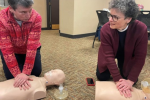October 19, 2011
The Edge Effect
I’ve just learned about “the edge effect.” In nature, the interface between two ecological systems – the edge – is one of the most fertile, diverse, resilient, innovative spaces. Think of a forest and a meadow, or a mountain and river valley. Taken separately, each system has unique characteristics that define its identity: the type of soil, availability of water, amount of sun, species of plants, and types of animals are different. Each can be a healthy, vital, stable little system on its own.
 But when different systems overlap, the potential for growth, abundance, diversity, resources, and resiliency increase. Therefore, one principle for creating sustainable ecological systems – or human cultures – is to “maximize the edges” or “value the marginal.” Maybe this is where we get the common phrase “the growing edge?”
But when different systems overlap, the potential for growth, abundance, diversity, resources, and resiliency increase. Therefore, one principle for creating sustainable ecological systems – or human cultures – is to “maximize the edges” or “value the marginal.” Maybe this is where we get the common phrase “the growing edge?”
On YouTube I found a video about the edge effect regarding woodland diversity. But last week I heard another intriguing example from a friend. In commenting about the Occupy Wall Street protest in New York City, she believed the location in Zuccotti Park is a major factor in its ability to generate attention. Not only is the location adjacent to Wall Street (the obvious point of the protest), but the encampment sits right in the middle of a densely packed, high traffic area of tourists and working people. There are a lot of edges, creating the opportunity for interaction, visibility, and engagement. Yes, the protest and encampment is disturbing the previous ecosystem in this place, but that’s the point. (Depending on your views, that may be a good thing or a bad thing!) While we have yet to see what fully emerges from this protest, this edgy event certainly exhibits signs of life and resiliency to date.
But what could the edge effect mean for our church life? Can we learn from this intriguing design principle of the Creator and apply it to our contemporary struggles? Can we follow in Jesus’ footsteps by walking in the intersections and margins of life?
Here are some questions we might ask:
- What are the core elements of your congregational identity? What’s the “DNA” of your church that makes it a unique, healthy, and Spirited place?
- Where is the perimeter of your congregation? How far are you reaching out, or do you feel encroached upon, and why?
- What other “systems” surround your congregation? Maybe the neighborhood, other organizations in your area, or groups of people who are different from you.
- How many edges do you have? Are they strong or porous boundaries? Is the activity along your edges showing signs of life or decay?
- If you were to focus on one growing edge for your congregation – striving for abundance, creativity, and resiliency - which one would it be, and why? What will be your first step toward maximizing its edge effect?





